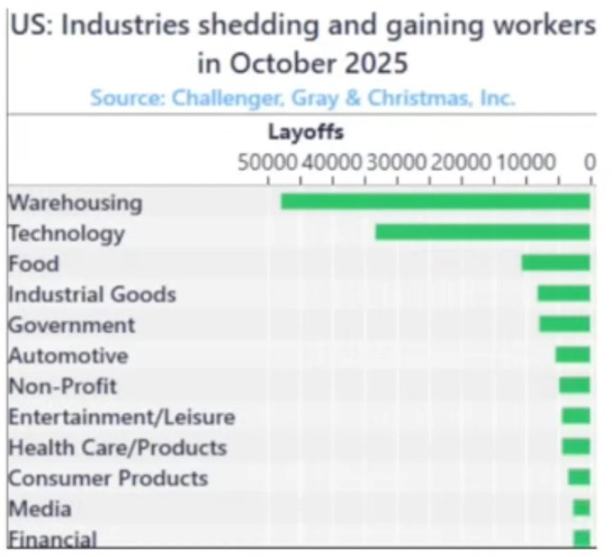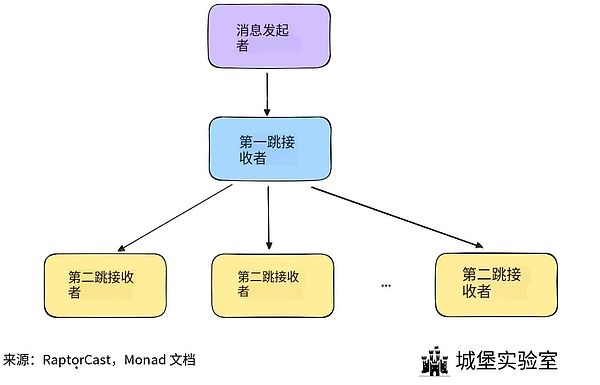Written by: arndxt
Translated by: AididiaoJP, Foresight News
The U.S. economy has split into two worlds: on one side, financial markets are booming; on the other, the real economy is slipping into a slow recession.
The Manufacturing PMI Index has contracted for over 18 consecutive months, the longest stretch since World War II, yet the stock market keeps rising as profits become increasingly concentrated among tech giants and financial companies. (Note: The full name of the "Manufacturing PMI Index" is the "Manufacturing Purchasing Managers' Index," which serves as a "barometer" for the health of the manufacturing sector.)
This is essentially "balance sheet inflation."
Liquidity continuously pushes up the prices of similar assets, while wage growth, credit creation, and small business vitality remain stagnant.
The result is an economic split, where during a recovery or economic cycle, different sectors move in completely opposite directions:
On one side: capital markets, asset holders, the tech industry, and large corporations surge (profits, stock prices, wealth).
On the other: wage earners, small businesses, blue-collar industries → decline or stagnate.
Growth and hardship coexist.
Policy Failure
Monetary policy can no longer truly benefit the real economy.

The Federal Reserve's rate cuts have pushed up stock and bond prices but have not brought new jobs or wage growth. Quantitative easing has made it easier for large corporations to borrow money but has not helped small businesses develop.
Fiscal policy is also nearing its limit.
Today, nearly a quarter of government revenue is used solely to pay interest on national debt.

Policymakers are thus caught in a dilemma:
Tighten policy to fight inflation, and the market stagnates; loosen policy to spur growth, and prices rise again. The system has become self-circulating: any attempt to deleverage or shrink the balance sheet will impact the asset values it relies on for stability.
Market Structure: Efficient Extraction
Passive fund flows and high-frequency data arbitrage have turned the public market into a closed-loop liquidity machine.
Positioning and volatility supply are more important than fundamentals. Retail investors have effectively become the counterparties to institutions. This explains why defensive sectors are abandoned, tech stock valuations soar, and the market structure rewards momentum chasing rather than value.
We have built a market with extremely high price efficiency but extremely low capital efficiency.
The public market has become a self-circulating liquidity machine.
Funds flow automatically → through index funds, ETFs, and algorithmic trading → creating continuous buying pressure, regardless of fundamentals.
Price movements are driven by capital flows, not value.
High-frequency trading and systematic funds dominate daily transactions, with retail investors actually on the other side of the trades. Stock price movements depend on positioning and volatility mechanisms.
Thus, tech stocks continue to expand while defensive sectors lag behind.

Social Backlash: The Political Cost of Liquidity
Wealth creation in this cycle is concentrated at the top.
The wealthiest 10% hold over 90% of financial assets; the higher the stock market climbs, the wider the wealth gap grows. Policies that push up asset prices simultaneously erode the purchasing power of the majority.
Without real wage growth and with homeownership out of reach, voters will eventually seek change—either through wealth redistribution or political upheaval. Both will intensify fiscal pressure and drive up inflation.
For policymakers, the strategy is clear: keep liquidity abundant, push markets higher, and claim economic recovery. Substitute superficial prosperity for substantive reform. The economy remains fragile, but at least the data can hold until the next election.

Cryptocurrency as a Pressure Valve
Cryptocurrency is one of the few areas where value can be held and transferred without relying on banks or governments.
Traditional markets have become closed systems, with large capital capturing most profits through private placements before IPOs. For the younger generation, bitcoin is no longer just speculation—it’s an opportunity to participate. When the entire system appears manipulated, at least here there’s still a chance.
Although many retail investors have been hurt by overvalued tokens and VC sell-offs, core demand remains strong: people long for an open, fair, and self-sovereign financial system.
Outlook
The U.S. economy cycles through "conditioned reflexes": tightening → recession → policy panic → liquidity injection → inflation → repeat.
The next round of easing may arrive in 2026, driven by slowing growth and widening deficits. The stock market will enjoy a brief rally, but the real economy will not truly improve unless capital shifts from supporting assets to productive investment.
At present, we are witnessing the late-stage form of a financialized economy:
-
Liquidity stands in for GDP
-
The market becomes a policy tool
-
Bitcoin serves as a societal pressure valve
As long as the system continues to cycle debt into asset bubbles, we will not achieve a true recovery—only a slow stagnation masked by rising nominal figures.



